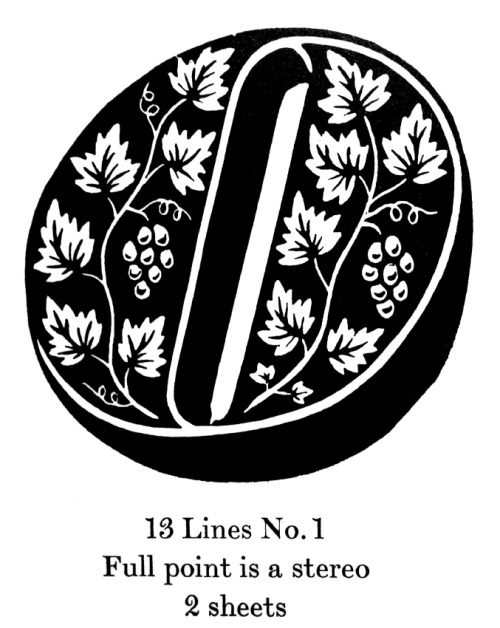









Louis John Pouchée alphabets
Described as the most ambitious and most beautiful types created in wood in any period, these alphabets were once presumed lost in a fire in 1940 at Monotype’s London office.
Designed for eye-catching headlines or for highlighting a word in printed posters, some of these fat face and slab serif letters look as if they could have been designed in the 1920s, or even the 1950s, judging from their patterns. They were actually designed in the early 1820s, even earlier than the more familiar Victorian ornamented type.
The astonishingly intricate letter designs feature a variety of ornamental motifs; plant forms, agricultural, musical and even masonic symbols. The level of detail in these, once innovative engravings, is incredible.
The above images are from Ornamented types: twenty-three Alphabets, from the Foundry of Louis John Pouchée. It’s a limited edition boxed set of large, unbound, deckled edged, printed sheets available to view at the St. Bride Library, which also holds the original wood blocks used to print the edition.
Printing from the blocks in the mid-90s was a collaboration between James Mosley, the former Librarian at St. Brides, and Ian Mortimer, of I.M. Imprimit, who designed and printed the limited edition.
When printing started, the provenance of the blocks was still a mystery. James Mosley had shown a few printed examples of individual letters in the ‘60s, suggesting that they might be from Pouchée’s foundry. However it wasn’t until Ian and his team were two-thirds through printing the cryptic alphabets that their identity was confirmed. Mosley matched them to a specimen; Specimens of stereotype casting, from the foundry of L. I. Pouchée 1, which even quotes the prices charged for the types.
The printing of this historic record was an extraordinary feat. The blocks were originally designed to be stereo-typed—used as patterns for casting metal type—and were never intended for printing. Therefore the blocks were never squared-up or made type high. This, together with the fact that their surfaces had warped slightly over time, meant that no automation for inking or printing could be used.
Painstaking techniques were used for making ready and inking the blocks. Each had to be packed and adjusted on the press to achieve a good impression. To ensure that both the engraved detail reproduced crisply and that the solid areas remained fully opaque, different sized rollers were often used on the same block to apply different densities of ink. A large roller with a fine film of ink was used for the detail and a small roller with thicker coverage was used for black areas. The few splits and marks, which eventually helped confirm the identity of the blocks, have been left. The edition took almost four years to complete.
Describing the design and typography of the printed edition, Ian told me that it had been agreed with Mosley that the letters should be allowed to speak for themselves with no clever layout or fancy typography to distract from them. The edition has a self-effacing layout with no secondary colour. The display type, Caslon’s two-line English Egyptian, was especially cast from surviving matrices. Two hundred and ten box sets were printed and it was agreed that the original blocks should not to be printed from again for fifty years.
Four of Pouchée’s printed letters were later used under license for the Pulp album cover, We Love Life, by Peter Saville in 2001.
I’ve chosen just a small section here. I was especially taken with the masonic alphabet. The ‘Z’, shown above, I’m told features authentic symbols that mark Pouchée out as a serious mason. Note the incredible printed detail achieved on the book in the centre and also the ‘G’ referring to God at the top. (Some of the other masonic letters show the eye of God). It was a privilege to be able to browse through it.
1The specimen title, shows founder’s name with an ‘I’.
The original Pouchée alphabets are © St Bride Foundation and I.M. Imprimit and are used with permission and my thanks.
Thanks also to Bob Richardson of the St. Bride Library—who first showed me the alphabets—and Ian Mortimer of I.M. Imprimit, for their time in answering questions and reviewing this post.
